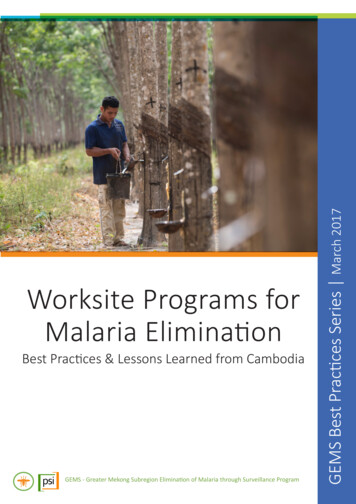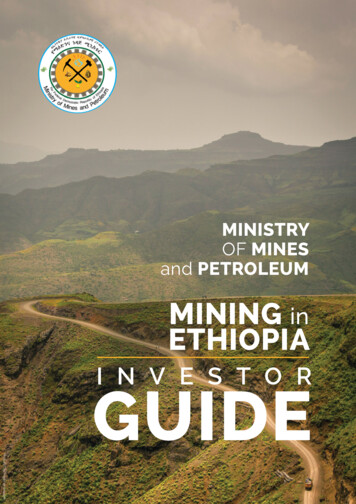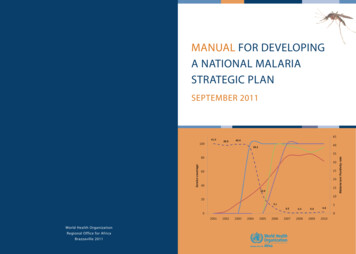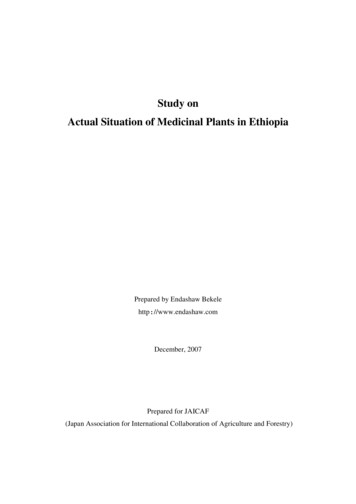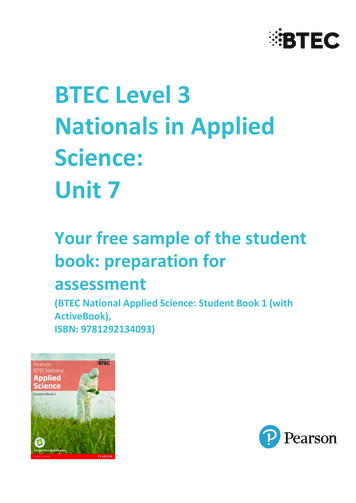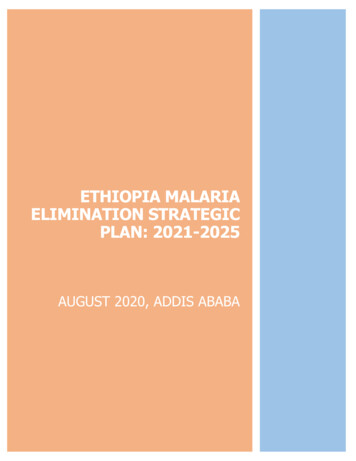
Transcription
ETHIOPIA MALARIAELIMINATION STRATEGICPLAN: 2021-2025AUGUST 2020, ADDIS ABABA
ETHIOPIA MALARIA ELIMINATION STRATEGIC PLAN: 2021-2025NATIONAL MALARIAELIMINATION STRATEGICPLAN: 2021-2025TOWARDS A MALARIA FREE ETHIOPIAAUGUST 2020ADDIS ABABA
ETHIOPIA MALARIA ELIMINATION STRATEGIC PLAN: 2021-2025FOREWORDEthiopia has scaled up and sustained coverage of key anti-malaria interventions for more than adecade. This scale-up made possible through the firm commitment of the government andsustained support from diverse partners. Consequently, significant reductions in malariaattributed mortality and morbidity were achieved in the country.This national malaria strategic plan (NMSP), which spans from 2021/22–2025/26 aims toconsolidate the gains made so far, sustain and expand impacts. The programme’s vision is to seea malaria-free Ethiopia. The country aims to achieve nationwide malaria elimination by 2030.Ensuring national capacity in terms of qualified workforce and improving institutional efficiencyas well as strengthening community engagement, empowerment and mobilization will be thebedrock on which the NMSP is to be built and be able to achieve its targets.The NMSP’s top priority is building a robust, timely, and effective surveillance and responsesystem. Such surveillance system will actively detect and respond to outbreaks, test, treat, andtrack individual cases, and investigate cases or foci with appropriate mitigation actions andmonitor overall progress in implementation of planned activities. Additionally, the NMSP strivesfor significant malaria burden reductions in high and moderate transmission settings, eliminatethe disease in low transmission districts and prevent reintroduction of malaria into districtsreporting zero indigenous malaria cases. In general, this strategy focuses on national malariaelimination programme, addresses the recommendations of the 2020 malaria programme reviewand responds to the major implementation gaps identified so far.I would like to take this opportunity to reaffirm that the Federal Ministry of Health is highlycommitted to providing the necessary leadership and required support for achieving the ambitioustargets of 2021/22 – 2025/26 NMSP. Finally, it is my firm trust that implementation of this strategywill advance the strides towards ending malaria from the country. Therefore, I sincerely call uponall partners to redouble their efforts for strides of the plan, which exceedingly contributes towardsthe vision of a ‘malaria-free Ethiopia’.Dr. Dereje DugumaState Minister of HealthI
ETHIOPIA MALARIA ELIMINATION STRATEGIC PLAN: 2021-2025ACKNOWLEDGEMENTSThe National Malaria Strategic Plan (NMSP) of 2021/22–2025/26 was developed through a seriesconsultations and active involvement of all stakeholders. The NMSP’s development demonstratedthe collaborative efforts of the Federal Ministry of Health (FMOH), Regional Health Bureaus,Programme partners, civil society organizations (CSOs), academia, research institutes, otherrelevant stakeholders and individuals. The FMOH would like to extend its sincere gratitude to allstakeholders and individuals who contributed tirelessly in the development of the NMSP.The National Malaria Elimination Programme and Diseases Prevention and Control Directoratedeserve special thanks for overall coordination and guidance in the development of the NMSP.Specifically, Hiwot Solomon and Mebrahtom Haile have demonstrated monumental leadershiprole throughout the development process of the NMSP. Moreover, the technical support givenfrom the technical advisory committee (TAC) was very instrumental in developing of the NMSP.In this regard, the Ministry would like to acknowledge the following institutions for their incrediblesupport: the World Health Organization (WHO), President’s Malaria Initiative (PMI), the UnitedStates Agency for International Development (USAID), the Malaria Control and EliminationPartnership in Africa (MACEPA)/PATH, Ethiopian Public Health Institute (EPHI), United NationsChildren’s Fund (UNICEF), Malaria Consortium, the International Center for AIDS Care andTreatment Programmes/Columbia University (ICAP), Addis Continental Institute of Public Health(ACIPH), VectorLink, and the Armauer Hansen Research Institute (AHRI), EthiopianPharmaceuticals Supply Agency (EPSA), Global Health Supply Chain - Procurement SupplyManagement (GHSC-PSM), John Hopkins University (JHU/CCP), Jimma University, ArbamichUniversity, Addis Ababa University (School of Health Sciences, Aklilu Lemma Institute ofPathobioloy and School of Public Health), all Regions’ malaria programme managers and technicaladvisors. In addition, PATH/MACEPA and WHO deserve special thanks for hiring local consultantswho supported the write-up of the NMSP.In conclusion, without the exhibited effective coordination and commitment, it would have beenimpossible to develop the NMSP in the midst of the covid-19 pandemic. The Ministry thereforeacknowledges the direct and indirect contributions of all that has made the development of theNMSP possible.II
ETHIOPIA MALARIA ELIMINATION STRATEGIC PLAN: 2021-2025TABLE OF CONTENTSFOREWORD . IACKNOWLEDGEMENTS . IIABBREVIATIONS . VLIST OF TABLES. VIIILIST OF FIGURES . VIIIEXECUTIVE SUMMARY . IXCHAPTER 1: INTRODUCTION . 11.1.Policy and Programming Environment . 11.2.Malaria Strategic Plan and the National Planning Cycle . 2CHAPTER 2: COUNTRY PROFILE. 42.1.Overview . 42.2.Sociopolitical System . 42.3.Demographic Data . 52.4.Ecosystem, Environment and Climate . 52.5.Socioeconomic Situation . 62.6.Health System Analysis . 7CHAPTER 3: MALARIA SITUATION ANALYSIS . 113.1.Historical Perspective of Malaria in Ethiopia . 113.2.Malaria Epidemiology . 123.2.1.Malaria parasites . 123.2.2.Malaria vectors . 133.2.3.Dynamics of malaria transmission. 153.2.4.Malaria stratification and mapping . 163.2.5.Malaria epidemics in Ethiopia. 193.2.6.Trends in morbidity and mortality . 203.3.Gender, Human Rights and Malaria . 22CHAPTER 4: REVIEW OF THE 2017-2020 PLAN . 244.1.NMSP achievements in line with the MPR findings . 244.2.Status of programme financing . 264.3.Key Challenges and Programmatic Gaps . 274.4.Lessons Learned and Way Forward . 28III
ETHIOPIA MALARIA ELIMINATION STRATEGIC PLAN: 2021-20254.4.1.Lessons learned in implementing NMSP. 284.4.2.Way forward . 28CHAPTER 5: MALARIA STRATEGIC PLAN FRAMEWORK. 305.1.Vision . 305.2.Mission. 305.3.Guiding Principles . 305.4.Strategic Directions and Policy Priorities . 315.5.Goals and Objectives . 345.5.1.Goals . 345.5.2.Strategic Objectives. 345.6.Strategies and Key Interventions . 34CHAPTER 6: IMPLEMENTATION FRAMEWORK . 396.1.NMSP Work Plan . 396.2.Implementation Arrangements . 396.2.1.Planning and implementation mechanisms . 396.2.2.Coordination of annual planning with subnational levels . 476.2.3.Partnership coordination system . 506.2.4.Procurement and supply management system . 506.2.5.Financial resource management. 516.2.6.Risk management and mitigation. 526.3.Budget of the MSP . 53CHAPTER 7: MONITORING AND EVALUATION . 577.1.Performance Framework . 577.2.Data Management System . 647.3.M&E Coordination Mechanisms . 67ANNEXES . 69Annex 1: Definition of Key Terms and Concepts . 69Annex 2: List of Contributors . 71Annex 3: Strengths, Weakness, Opportunity and Threats Analysis. 73REFERENCES . 75IV
ETHIOPIA MALARIA ELIMINATION STRATEGIC PLAN: HGDPGISGNIGTPGTSHDIHEPHEWHISAddis Ababa UniversityAddis Continental Institute of Public HealthAdvocacy, Communication and Social MobilizationArtemisinin-based Combination TherapyAgricultural Development AgentArmauer Hansen Research InstituteArtemether-lumefantrineAnnual Parasite IncidenceAnnual Review MeetingAfrican UnionCoordinating CommitteeCountry Coordinating Mechanism-EthiopiaCenter for Public Health Emergency ManagementCentral Statistical AgencyCommunity ScorecardCivil Society OrganizationDisability-Adjusted Life YearDichloro-Diphenyl-TrichloroethaneDigital Elevation ModelDistrict Health Information SystemDiseases Prevention and Control DirectorateEnumeration AreaElectronic Community Health Information SystemEthiopian Demographic and Health SurveyEthiopian Food and Drug AuthorityEthiopian Fiscal YearEthiopian Hospitals Alliance for QualityEthiopian Health Centers Reform Implementation GuidelinesEnhancing National Climate ServicesEl Nino Southern OscillationEthiopian Primary Health Care Alliance for QualityEthiopian Public Health InstituteEthiopian Pharmaceuticals Supply AgencyExternal Quality AssessmentFederal Ministry of HealthGross Domestic ProductGeographic Information SystemGross National IncomeGrowth and Transformation PlanGlobal Technical StrategyHuman Development IndexHealth Extension ProgrammeHealth Extension WorkerHealth Information SystemV
ETHIOPIA MALARIA ELIMINATION STRATEGIC PLAN: SUFISWOTTACTORTWGUNHealth Management Information SystemHealth, Population and NutritionHuman Resource DevelopmentHealth Sector Transformation PlanIntegrated Community Case ManagementInternally Displaced PeopleInsecticides Resistance Monitoring and Management StrategyIndoor Residual SprayingIntegrated Refresher TrainingInsecticide Treated NetKey Performance IndicatorLong Lasting Insecticidal NetLogistic Management Information SystemMonitoring and EvaluationMalaria Control and Elimination Partnership in AfricaMaternal and Child HealthMinistry of FinanceMinistry of HealthMalaria Programme ReviewMalaria Strategic PlanMid-Term ReviewNon-Communicable DiseaseNormalized Difference Vegetation IndexNon-Governmental OrganizationNational Meteorological AgencyNational Malaria Control and Elimination ProgrammeNational Malaria Strategic PlanPartnership for Appropriate Technology in HealthPrimary Health Care UnitPresident’s Malaria InitiativePersonal Protective EquipmentPublic Private MixPolicy, Planning, Monitoring and Evaluation DirectoratePurchasing Power ParityRegional Health BureauServices Availability and Readiness AssessmentSocial and Behavior Change CommunicationSustainable Development GoalsStrengthening Malaria Monitoring and Evaluation SystemSulfadoxine-pyrimethamineScale Up For ImpactStrengths, Weakness, Opportunities and ThreatsTechnical Advisory CommitteeTerm of ReferenceTechnical Working GroupUnited NationVI
ETHIOPIA MALARIA ELIMINATION STRATEGIC PLAN: 2021-2025UNDPUNICEFUSAIDVPNWHOWMRWMSWoHOUnited Nation Development ProgrammeUnited Nations Children’s FundUnited States Agency for International DevelopmentVirtual Private NetworkWorld Health OrganizationWorld Malaria ReportWoreda Management StandardsWoreda Health OfficeVII
ETHIOPIA MALARIA ELIMINATION STRATEGIC PLAN: 2021-2025LIST OF related indicators, DHS of 2005, 2011, 2016 and 2019 . 82. Percentage of malaria parasite from sentinel sites, 2016-2019, NMEP . 123. Percentage of malaria species based on HMIS data, 2015 - 2019 . 134. Malaria stratification with estimated population distribution, NMEP, June 2020. . 185. Proposed interventions by stratum, July 2020, NMEP. . 196. Malaria-specific and all cause admissions and death, NMEP, Ethiopia . 217. Cost of the national strategic plan (2017-2020) by intervention. 268. Status of Global Fund budget disbursement and utilization (2017-2019) . 269. Status of PMI/USAID budget disbursement and utilization (2017-2019) . 2710. Status of government budget utilization (2017-2019) . 2711. Implementation logframe of NMSP 2021/22-2025/26 . 4012. Anticipated risks and mitigation measures. 5213. Budget summary by objectives (USD) . 5414. Summary of projected cost by major interventions (USD) . 5515. Expected financial commitment by source, NMEP, 2020. . 5516. NMSP gap analysis . 5617. Performance framework. 58LIST OF igureFigureFigure1. Ethiopia Health Tier System . 82. Percent of malaria parasite species reported from sentinel sites, 2016-2019. . 123. Malaria stratification map, June 2020, NMEP. . 194. Trend of suspected and confirmed malaria cases, 2016-2019, NMEP, Ethiopia . 215. Percentage of malaria attributed admissions and deaths, NMEP, Ethiopia . 226. Trend of malaria-attributed deaths in Ethiopia from 2012 to 2019, NMEP, Ethiopia . 227. Organizational structure of the Ministry of Health . 478. NMSP implementation arrangement map . 499. Conceptual framework of data quality assurance . 6410. Overview of data source, flow and use in malaria M&E system. 67VIII
ETHIOPIA MALARIA ELIMINATION STRATEGIC PLAN: 2021-2025EXECUTIVE SUMMARYThe Ethiopian national malaria strategic plan (NMSP), which spans from 2021 to 2025, wasdeveloped after conducting malaria programme review (MPR) for the preceding NMSP andthrough a series consultations and active involvement of all stakeholders. It builds up onachievements made in the last NMSP and addresses gaps encountered during the previousstrategic plan. The NMSP is fully aligned with policies, guidance, and evidences at global, regionaland national levels and considers recent developments. The purpose of this NMSP is to articulatethe national malaria programme’s direction and implementation strategies so that efforts by allpartners are harmonized towards sustaining universal coverage and putting Ethiopia on track formalaria elimination. It also provides indicative figures on the resources required for theimplementation of the planned activities.Vision: To see malaria free Ethiopia.Mission: The Malaria Programme will provide quality, equitable and effective anti-malariaservices and maintain proven anti-malaria interventions to all at risk populations of Ethiopiathrough community empowerment, mobilization and ownership, an integrated health systemapproach, strong partnership and by ensuring technical excellence.Guiding Principles: The NMSP considers the following guiding principles - shared values andethical standards: Fairness or equity. Value for money (efficiency). People-centered. Evidence-based public health practice. Partnership for success.Goals1. By 2025, reduce malaria morbidity and mortality by 50 percent from baseline of 2020.2. By 2025, achieve zero indigenous malaria in districts with annual parasite incidence less than10 and prevent reintroduction of malaria in districts reporting zero indigenous malaria cases.Strategic Objectives1. By 2025, achieve adoption of appropriate behaviour and practices towards antimalarialinterventions by 85% households living in malaria endemic areas.IX
ETHIOPIA MALARIA ELIMINATION STRATEGIC PLAN: 2021-20252. By 2021 and beyond, conduct confirmatory testing for 100% of suspected malaria cases andtreat all confirmed cases according to the national guidelines.3. By 2021 and beyond, cover 100% of the population at risk of malaria with one type of globallyrecommended vector control interventions.4. By 2021 and beyond, conduct cases or foci investigation, classification and response indistricts currently having API less than 10 and prevent reintroduction of malaria into areasreporting zero indigenous malaria cases.5. By 2021 and beyond, generate 100% evidence that facilitates appropriate decision-making.6. By 2021 and beyond, build capacity of all levels of the health offices to coordinate andimplement malaria elimination interventions.Implementation Strategies1. Enhancing community engagement, empowerment and mobilization2. Ensuring early diagnosis and prompt treatment3. Strengthening vector control4. Improving malaria surveillance and response system5. Improving malaria supply chain and quality of antimalarial commodities6. Ensuring human rights and gender equality in accessing malaria services7. Strengthen engagement of all stakeholders, including civil society organizations (CSOs) andprivate sector8. Strengthening malaria programme management, operational research and M&E.Implementation ArrangementsThe malaria programme is fully integrated at all levels of the decentralized health system of thecountry. The national programme provides guidance to all health offices and partners working inall aspects of malaria programme related issues. The programme has been supported by strongpartnership and there are well-established system and forums for partnership coordination in thecountry. The programme works closely with the Ethiopian Pharmaceuticals Supply Agency tofacilitate timely forecasting, procurement, clearing, and distribution of quality of antimalarialproducts; and promote rational use of malaria supplies. In addition to government structures,CSOs and private sectors will engage in implementation of the NMSP.Monitoring and follow-up of implementation of the core activities and funding will be overseen bythe central joint steering committee, which convenes FMOH and health population and nutritionX
ETHIOPIA MALARIA ELIMINATION STRATEGIC PLAN: 2021-2025partners and the FMOH-Regional joint steering committees. Global Fund–specific programminghas been overseen by the Country Coordinating Mechanism (CCM), which is chaired by theMinister of Health and co-chaired by a representative of CSOs.BudgetActivity-based costing was done and the total cost of the NMSP for the five years is USD532,009,146. The total funding projected to be available, including the GF source (USD105,344,134 for the first three years) is USD 364,127,971 (68%) thus resulting in a funding gapof USD 167,881,175.XI
ETHIOPIA MALARIA ELIMINATION STRATEGIC PLAN: 2021-2025CHAPTER 1: INTRODUCTIONThis malaria national strategic plan (NMSP), which spans from 2021 to 2025, was developed afterconducting malaria programme review (MPR) for the preceding MSP. Accordingly, it builds uponachievements made in the last NSP and addresses identified gaps. The NMSP is fully aligned withpolicies, guidance, and evidence at global, regional, and national levels and considers recentdevelopments.The purpose of this NMSP is to articulate the national malaria programme’s direction andimplementation strategies so that efforts by all partners are harmonized towards sustainingantimalarial interventions’ coverage and putting Ethiopia on track for malaria elimination. It alsoprovides indicative figures on the resources required for the implementation of the plannedactivities to emphasize the need to hasten resource mobilization efforts. This MSP also serves asa guide for the development of plans of action at various levels. This section particularlydescribes the overview of policy and programme environment, NMSP and the nationalplanning cycle in relation to malaria elimination programme.1.1.Policy and Programming EnvironmentIn Ethiopia, malaria remains to be one of the major public health and socioeconomic problemsdespite its dramatic reduction in the last two decades. Apart from illness and deaths, it pausedpersistent socio-economic impacts particularly to more than eighty per cent of the country’s ruralcommunity. For example, overlapping of transmission of the disease with the major harvestingand other agricultural activities contributes to a massive loss of productivity. A survey showedthat malaria accounts for loss of 30% of the overall disability adjusted life years (DALYs) as wellas imposing a high economic cost1. Accordingly, malaria stands to be one of the top priorityprogrammes in the national health and overall socioeconomic development agenda. Malariaprevention, control and elimination have been given due attention by the government and itspartners. Moreover, the country launched a malaria elimination programme, which in turndemonstrated the government’s commitment in the fight against the disease.As part of this effort, the national government has allocated necessary resources for malariaelimination. In addition, the government of Ethiopia has been working closely with local, regional1Ethiopian Public Health Institute, 2018. Services availability and readiness assessment (SARA). EPHI, 2018: 1-94.1
ETHIOPIA MALARIA ELIMINATION STRATEGIC PLAN: 2021-2025and global partners and is wholly committed to regional and global malaria prevention, controland elimination agreements, strategies and targets. Ethiopia is an active member state of theAfrican Union (AU), World Health Organization (WHO) and other United Nations (UN) agencies.Its strategies and targets include, among others, African Union Catalytic Framework to End AIDS,TB and Eliminate Malaria in Africa by 2030, the World Health Organization WHO global technicalstrategy for malaria, 2016-30 (GTS) and the target (target 3.3) of the sustainable developmentgoals (SDGs) of the UN. The GTS 2025 goals and targets are to reduce both malaria mortalityand incidence rates globally by at least 40%, 75% and 90% respectively, by 2020, 2025, and2030 compared with 2015. The framework for implementing the GTS for Malaria 2016–2030 inthe African Region is recommended the adoption of programme phasing and transitioning, aimedat facilitating a tailored approach to malaria control/elimination.To effectively implement the planned interventions and eliminate malaria, necessary strategieshave been designed and adopted, scaled-up and sustained over the years. As part of the NMSP2021-2025 development, strengths, weakness, opportunity and threat (SWOT) analysis of theprogramme was performed. The SWOT analysis uniquely depicts that the current COVID-19pandemic posed plausible impacts on the health system through its implication on sapping thelimited resources and diverting priority. Consequently, implementing malaria elimination couldalso face plausible challenges and ought to consider the worst scenario like absence of effectiveinterventions like vaccine to the COVID-19 in the upcoming years, possibly for at least the firsttwo years of the NMSP.1.2.Malaria Strategic Plan and the National Planning CycleThe country has recently developed its national growth and transformation plan (GTP) and eachsector office contributed its sector-specific plan. This plan has detailed activities with milestonesfor the coming five years and incorporates some indicative benchmarks for the coming decade.Accordingly, the health sector plan was developed and incorporated into the nationaltransformation plan. I
PPMED Policy, Planning, Monitoring and Evaluation Directorate PPP Purchasing Power Parity RHB Regional Health Bureau SARA Services Availability and Readiness Assessment SBCC Social and Behavior Change Communication SDGs Sustainable Development Goals SMMES Strengthening Malaria Monitoring and Evaluation System SP Sulfadoxine-pyrimethamine
